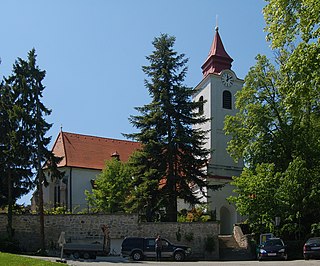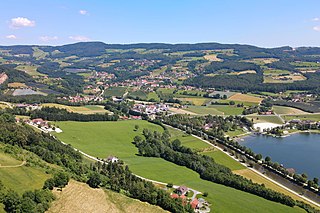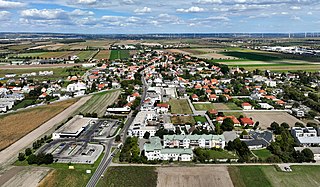
Krems an der Donau is a town with 25,271 inhabitants end 2022 in Austria, in the federal state of Lower Austria. It is the fifth-largest city of Lower Austria and is approximately 70 kilometres west of Vienna. Krems is a city with its own statute, and therefore it is both a municipality and a district.

Leobersdorf is a town in the Baden district of Lower Austria, Austria.

Mürzzuschlag is a town in northeastern Styria, Austria, the capital of the former Mürzzuschlag District. It is located on the Mürz river near the Semmering Pass, the border with the state of Lower Austria, about 85 km (53 mi) southwest of Vienna. The population is 8,684. Originally an industrial area, the nearby mountains are today a popular ski resort.

Bruck an der Leitha is a town in the state of Lower Austria of Austria on the border of Burgenland, marked by the Leitha river. In 2018 it had a population of around 8,000.

Pernitz is a town in the district of Wiener Neustadt-Land in the Austrian state of Lower Austria.

Kapfenberg, with 22,182 inhabitants in 2023, is the third largest city in Styria, Austria, and lies in the valley of the Mürz near the town of Bruck an der Mur. The town's landmark is Burg Oberkapfenberg. Every year in June, the Ritterfest takes place at the castle, which is one of the largest events of its kind in Austria.

Schwaz is a city in the Austrian state of Tyrol. It is the administrative center of the Schwaz district. Schwaz is located in the lower Inn valley.

Laa an der Thaya is a town in the Mistelbach District of Lower Austria in Austria, near the Czech border. The population in 2016 was 6,224.

Bezirk Baden is a district of the state of Lower Austria in Austria.

Alland is a market town in the district of Baden in the Austrian state of Lower Austria.
Altenmarkt an der Triesting is a town in the district of Baden in Lower Austria in Austria.

Berndorf is a town in the district of Baden in Lower Austria in Austria. Because of its historic development in the 19th century it is also referred to as the Krupp town.

Enzesfeld-Lindabrunn is a town in the district of Baden in Lower Austria in Austria. The city was governed by social democracy until 2010, and since 2010 a citizens' list of Franz Scheider has been in power.
Pottenstein is a town in the district of Baden in Lower Austria in Austria.

Angern an der March is a market town in the district of Gänserndorf in the Austrian state of Lower Austria. The municipality consists of the Katastralgemeinden Angern, Grub, Mannersdorf, Ollersdorf and Stillfried.

Köflach is a small city in the district of Voitsberg in the Austrian state of Styria, at the foot of the Stubalpe mountain. The town has a federal stud in the village of Piber that supplies the Lipizzaner horses to the famous Spanish Riding School in Vienna. Traditionally known for its coal mining, Köflach is slowly changing from an industrial town to a center of the service sector. It is connected by rail to Voitsberg.

Wals-Siezenheim is a municipality in the district of Salzburg-Umgebung (Flachgau) in the Austrian state of Salzburg.

Stubenberg, called Stubenberg am See, is a municipality in the district of Hartberg-Fürstenfeld, in Styria, Austria. It is located roughly 50 km from Graz and 200 km from Vienna. It has a population of 2.287 as of April 2010.

Gerasdorf bei Wien is a town in the district of Korneuburg in the Austrian state of Lower Austria. The city has 10,862 inhabitants.
Stainach-Pürgg is a municipality since 2015 in the Liezen District of Styria, Austria.



















